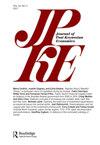Post-Keynesian liquidity preference theory four decades later: a reexamination
IF 1
3区 经济学
Q4 ECONOMICS
引用次数: 0
Abstract
AbstractTracy Mott was best known as a scholar of the work of Michal Kalecki, but he also made an important contribution to Keynesian liquidity preference theory. In 1983 Tom Asimakopulos generated a firestorm in the Post Keynesian community with a series of articles claiming that while Keynes’s argument is that investment creates an equivalent amount of saving, this is true only ex post, after the multiplier has fully operated. Meantime, lack of savings could inhibit investment as the supply of bonds for long-term finance would exceed the supply of savings, driving up interest rates. Several Post Keynesians vociferously responded in defense of Keynes. Mott’s contribution to the debate approached the subject from a perspective that was more heavily influenced by Kalecki, Robinson, and Marx. Not only does the outcome of this debate impact our view of investment finance, but it also has implications for our view of financing government deficits. In this piece, I look back at Mott’s contribution to our understanding of liquidity preference, taking account of developments in Post Keynesian thought over the past four decades. The two most obvious and relevant are the endogenous money approach and Modern Money Theory.Keywords: Tracy Mottliquidity preferenceAsimakopulosMMTsaving and investment Notes1 Note that I will follow typical Post Keynesian practice in using the term “savings” to refer to a stock, and “saving” to refer to a flow.2 As it happened, Tom Asimakopulos had been one of my mentor’s (John Henry) professors and we met up at several of the Post Keynesian summer schools—first at Trieste and then in Knoxville. Tom was hurt by the reaction to his articles and believed that none of the critics really understood the point he was making. After many discussions, I was never clear on his interpretation of the critiques.3 See Snippe (Citation1985), Terzi (Citation1986), Davidson (Citation1986), Wray (Citation1988), and Kregel (Citation1984, Citation1986, Citation1988) for early critiques, Asimakopulos (Citation1985, Citation1986a, Citation1986b) for some of his responses, Sardoni (Citation2019 and Citation2020) for a recent defense, and Lavoie and Zezza (Citation2020) for a response to Sardoni. I will focus on Mott’s contributions.4 That is, “m” is the marginal propensity to buy bonds out of savings, presumed to be less than one. See Davidson (Citation1978).5 Note also that the investment project and sale of bonds can be completed before “equilibrium” as defined by Asimakopulos to mean full operation of the multiplier, if, for example, inventories have not been fully replaced in the consumption sector.6 Quoted in Kregel Citation2019; equating saving (ex ante or ex post) with finance is a category error. See his chapter for further discussion of this point.7 This follows from the Kalecki profit equation: a reduction of the budget deficit and an increase of a current account deficit reduce profit flows and make it difficult to service debt.8 See Wray (Citation1990, 116–123) for discussion of Keynes’s views, and Wray (Citation1998) for an early exposition of MMT.9 See Wray (Citation1990, 135–138) for discussion of Minsky’s views.10 He went on to argue: “If the structure of government expenditure and taxation is such that the government deficit is a decreasing function of the level of income in the economy, then the increase in saving generated by an increase in investment will be less than this increase in investment. The consequent decrease in the government deficit dampens the multiplier effects of the increase in investment in a manner similar to the increase in imports in an open economy” (1983 231)11 Note that readers should not jump to the conclusion that MMT argues that government spending automatically creates an equivalent amount of tax revenue—as one referee did. In the expanded injection-leakage model, an increase of one injection—such as government spending—raises income sufficiently that the total of the leakages (including taxes) rises to equal the increase of the injection. Further, as the Godley sectoral balance equation shows, an increase of the government’s deficit will increase the surplus of at least one other sector (domestic private sector or foreign sector). However, as Wray and Nersisyan (Citation2020) have shown, a sustained increased of the government budget deficit does increase economic growth, which increases tax revenue so that the deficit falls; as growth slows with the falling deficit, tax revenue growth falls and that opens up the deficit. This process repeats itself cyclically.12 To be clear, I am not accusing Asimakopulos of this confusion—he consistently argued that injections are causally prior to leakages. However, he believed that impacts on interest rates could be induced by injections that outpace desired saving.13 As J. Fagg Foster (Citation1981) put it, saving is the “pecuniary accountancy” of investment—the equality is guaranteed by accounting.Additional informationNotes on contributorsL. Randall WrayL. Randall Wray is at Levy Economics Inst, Annandale on Hudson, New York, USA.后凯恩斯流动性偏好理论四十年后:重新审视
摘要特蕾西·莫特以研究卡莱茨基的著作而闻名于世,但他对凯恩斯的流动性偏好理论也做出了重要贡献。1983年,汤姆•阿西马科普洛斯(Tom Asimakopulos)发表了一系列文章,声称尽管凯恩斯的论点是投资创造了等量的储蓄,但这只有在乘数完全发挥作用之后才成立。与此同时,储蓄不足可能抑制投资,因为用于长期融资的债券供应将超过储蓄供应,从而推高利率。一些后凯恩斯主义者大声回应,为凯恩斯辩护。莫特对这场辩论的贡献是从卡莱茨基、罗宾逊和马克思影响更大的角度来探讨这个问题的。这场辩论的结果不仅影响了我们对投资融资的看法,也影响了我们对政府赤字融资的看法。在这篇文章中,我将回顾莫特对我们理解流动性偏好的贡献,并考虑到过去40年来后凯恩斯主义思想的发展。最明显和最相关的两个理论是内生货币理论和现代货币理论。关键词:特雷西·莫特流动性偏好、马科普洛斯、储蓄和投资注1请注意,我将遵循典型的后凯恩斯主义做法,用“储蓄”一词指代股票,用“储蓄”一词指代流动碰巧,汤姆·阿西马科普洛斯是我的导师(约翰·亨利)的教授之一,我们在几个后凯恩斯主义的暑期学校见过面——先是在的里雅斯特,然后在诺克斯维尔。人们对他的文章的反应伤害了汤姆,他认为没有人真正理解他的观点。经过多次讨论,我始终不清楚他对这些评论的解释参见Snippe (Citation1985), Terzi (Citation1986), Davidson (Citation1986), Wray (Citation1988)和Kregel (Citation1984, Citation1986, Citation1988)的早期评论,asimakopullos (Citation1985, Citation1986a, Citation1986b)的一些回应,Sardoni (Citation2019和Citation2020)最近的辩护,以及Lavoie和Zezza (Citation2020)对Sardoni的回应。我将重点介绍莫特的贡献也就是说,“m”是用储蓄购买债券的边际倾向,假设小于1。参见Davidson (Citation1978)还请注意,投资项目和债券的销售可以在Asimakopulos定义的“均衡”之前完成,即乘数的充分运作,例如,如果消费部门的库存没有完全取代引用于Kregel Citation2019;将储蓄(事前或事后)等同于金融是一种分类错误。关于这一点的进一步讨论见他的章节这是由卡莱茨基利润方程得出的:预算赤字的减少和经常账户赤字的增加减少了利润流,使其难以偿还债务参见Wray (Citation1990, 116-123)对凯恩斯观点的讨论,以及Wray (Citation1998)对mmt的早期阐述。9参见Wray (Citation1990, 135-138)对明斯基观点的讨论他接着指出:“如果政府支出和税收的结构是这样的,即政府赤字是经济中收入水平的递减函数,那么投资增加所带来的储蓄增长将小于投资的增长。”随之而来的政府赤字的减少抑制了投资增加的乘数效应,其方式类似于开放经济中进口的增加。”(1983 231)11请注意,读者不应像一位裁判那样,直接得出MMT认为政府支出会自动创造等量的税收收入的结论。在扩大的注入-泄漏模型中,增加一笔注入——比如政府支出——足以增加收入,以至于总泄漏(包括税收)的增加与注入的增加相等。此外,正如戈德利部门平衡方程所示,政府赤字的增加将增加至少一个其他部门(国内私营部门或外国部门)的盈余。然而,正如Wray和Nersisyan (Citation2020)所表明的那样,政府预算赤字的持续增加确实会促进经济增长,从而增加税收收入,从而降低赤字;随着经济增长放缓,赤字下降,税收收入增长下降,从而扩大了赤字。这个过程循环地重复需要澄清的是,我并不是在指责Asimakopulos造成了这种混乱——他一直认为注射是先于泄漏的因果关系。然而,他认为,如果注入资金的速度超过预期的储蓄速度,可能会对利率产生影响正如J. Fagg Foster (Citation1981)所说,储蓄是投资的“金钱会计”——平等是由会计保证的。 其他信息:贡献者说明兰德尔WrayL。兰德尔·雷(Randall Wray)就职于美国纽约州哈德逊河畔安南代尔的利维经济研究所。
本文章由计算机程序翻译,如有差异,请以英文原文为准。
求助全文
约1分钟内获得全文
求助全文
来源期刊

Journal of Post Keynesian Economics
ECONOMICS-
CiteScore
1.70
自引率
10.00%
发文量
23
期刊介绍:
The Journal of Post Keynesian Economics is a scholarly journal of innovative theoretical and empirical work that sheds fresh light on contemporary economic problems. It is committed to the principle that cumulative development of economic theory is only possible when the theory is continuously subjected to scrutiny in terms of its ability both to explain the real world and to provide a reliable guide to public policy.
 求助内容:
求助内容: 应助结果提醒方式:
应助结果提醒方式:


